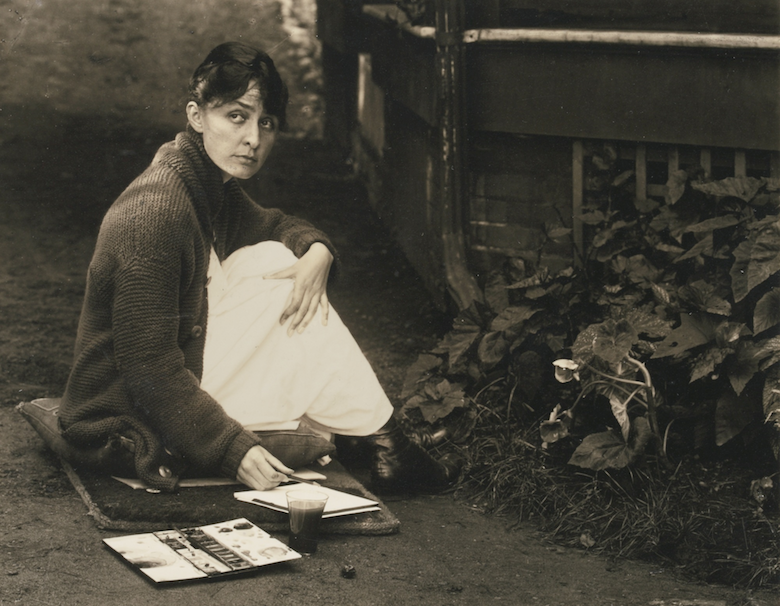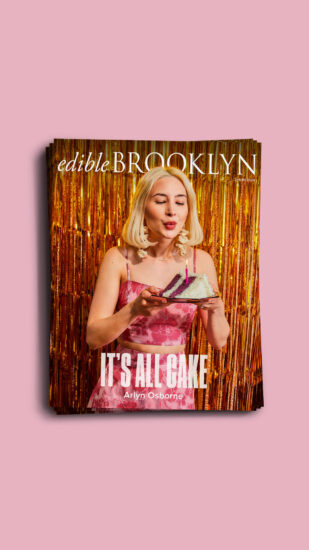
When Robyn Lea cleared security at the Georgia O’Keeffe Research Center in Sante Fe, New Mexico, she received a large black box. Having submitted a written request for recipe and garden books two weeks earlier, it wasn’t what she expected. Inside, however, were dozens of O’Keeffe’s recipes—including handwritten cards, magazine and newspaper clippings—that hadn’t been formally processed by staff. Lea had arrived that day expecting to comb book annotations for enough source material for a potential project and left with more than enough items to compile an entire cookbook, which she has.
Her collection Dinner with Georgia O’Keeffe: Recipes, Art & Landscape (published by Assouline) explores a few central questions: “Can we learn something from [O’Keeffe’s] approach to food and its relationship to her love of nature that helps us see her work in a new way? Did O’Keeffe eat as she painted, as she dressed, as she spoke? And when we bring her favorite dishes to our table, can it help us rethink the role of food, art and nature in our own lives?” Spoiler: The book of course offers an unequivocal yes to each of these weighty questions with delicious and often modernized recipes. But even without taking on these Art History 101 essay prompts, it’s just simply fun to cook and eat like O’Keeffe did.

O’Keeffe’s tastes could describe the way many of us aspire to eat now. She generally favored a plant-based diet (including produce from her own garden) with whole grains, minimally processed ingredients and lots of flavor. She valued what she understood to be a healthy diet at the time and made dishes like “Hearty Greek Lentil Soup” (from Live Longer Now: The First One Hundred Years of Your Life), “Chicken Congee with Ginger & Fresh Herbs” (Cook Right—Live Longer: The Lelord Kordel Cookbook) and “Savitri’s Indian Meat Koftas with Spices & Fresh Herbs” (from Savitri Chowdhary’s Indian Cooking).
For every healthy dish though, Lea’s book includes a decadent dessert, breakfast or bread. In Lea’s description of “Harriet’s Vanilla Layer Cake with Chocolate Frosting” she writes: “[O’Keeffe] was known to admonish staff for eating sugary foods, though, in her own handwritten recipe collection, there were a number of rich desserts.” This includes the following “Pancakes for One” that, despite the title, actually makes 10 to 12 small pancakes (I imagine O’Keeffe’s wry smile).
These humanizing details are the real pleasure of Lea’s compilation. Something similar could be said of the current Georgia O’Keeffe: Living Modern show now at the Brooklyn Museum (closing July 23) that juxtaposes her wardrobe with her work, displaying an undeniable consistency of O’Keeffe’s iconic tastes throughout many realms of her life. The exhibition’s guest curator Wanda Corn best describes what the show’s selections—and these pancakes, I’d argue—reveal: “[O’Keeffe] was a walking exemplar of that simple idea that art should not be separate from life.” I encourage you to go see the show and try this recipe for yourself.

Pancakes for One
Pancakes were a breakfast favorite for O’Keeffe and were often prepared for her by a staff member, using flours such as whole wheat, buckwheat or ground sunflower seed. She had various preferred pancake recipes, such as oatmeal pancakes, whole-wheat and buttermilk pancakes and sunflower seed pancakes—all three from Stella Standard’s 1951 book Whole Grain Cookery—as well as buckwheat cakes from Irma S. Rombauer’s Joy of Cooking. Artist Christine Taylor Patten, who was one of O’Keeffe’s caretakers in 1983, “would bring her breakfast and supper into the studio or she’d eat on a little table in her bedroom, in a corner beneath a window where she would be warm if there were sunshine.”
This recipe was handwritten in O’Keeffe’s lovely flowery script on an index card. The pancakes can be topped with any number of combinations, including fresh garden fruit, poached or preserved fruit, banana and maple syrup, or lemon juice and sugar. While O’Keeffe titled this recipe Pancakes for One, it makes approximately 10 to 12 small pancakes—which would be a very large meal for one person—or it can be divided into smaller portions for two.
Makes 10–12 small pancakes
1 egg
½ cup buttermilk, plus more as needed
¼ cup whole wheat flour
1 teaspoon brewer’s yeast
¼ teaspoon wheat germ
1 teaspoon baking powder
½ teaspoon raw sugar
¼ teaspoon salt
Butter, for the griddle
In a large bowl, beat the egg well with a fork, then stir in the ½ cup buttermilk. Sift in the flour, then add the remaining ingredients and stir to combine; add more buttermilk, if desired, for thinner cakes. Transfer to a pitcher for ease of pouring.
Grease a hot griddle with butter. Pour batter onto the griddle to make 2-inch pancakes, flipping when bubbles appear on top and the bottoms are browned, 2 to 4 minutes. Cook the second side just until browned.
Photos, text and recipe reprinted with permission from Dinner with Georgia O’Keeffe: Recipes, Art & Landscape by Robyn Lea, copyright © 2017. Published by Assouline Publishing.



